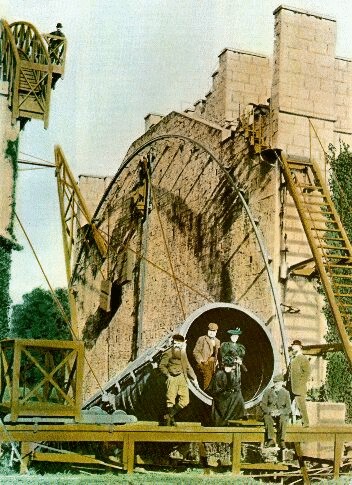Their light gathering power was far superior
(i.e., by an order of magnitude) to previous telescopes:
<<Not until 1866 did refracting telescopes reach 18 inches in aperture.>>
------------------------------------------------
Besides, prior to 1935, Mount Wilson's telescopes also had
oxidation problems and had to be re-silvering every few months:
.............................................
http://en.wikipedia.org/wiki/History_of_the_telescope
<<Mount Wilson Observatory’s 60-inch (1.5 m) reflector in 1908, and the 100 inch (2.5 m) Hooker telescope in 1917 had to have provisions to allow for the removal of their main mirrors for re-silvering every few months. John Donavan Strong, a young physicist at the California Institute of Technology, developed a technique for coating a mirror with a much longer lasting aluminum coating using thermal vacuum evaporation. In 1932, he became the first person to “aluminize” a mirror; three years later the 60-inch and 100-inch telescopes became the first large astronomical telescopes to have their mirrors aluminized.>>
------------------------------------------------
Note that 2008 is also the 100th anniversary
of the demise of the Leviathan of Parsonstown.
Jonah spent spent three days and three nights which was
about the same number of clear skies opportunities
Bill Parsons had each month in his Dobsonian:
 http://www.klima-luft.de/steinicke/Arti ... birr_e.htm
http://www.klima-luft.de/steinicke/Arti ... birr_e.htm
--------------------------------------------------------------
Irish astronomer and telescope builder (1800–1867)
http://www.answers.com/topic/rosse-will ... 3d-earl-of
<<The eldest son of the second earl of Rosse, William Parsons was born at York in England. He was educated at Trinity College, Dublin, and Oxford University, where he graduated in 1822. He was a member of parliament from 1822 until 1834, when he resigned to devote himself to science.
Rosse's main aim was to build a telescope at least as large as those of William Herschel. As Herschel had left no details of how to grind large mirrors, Rosse had to rediscover all this for himself. It was not until 1839 that he had made a 3-inch (8-cm) mirror; this was followed by mirrors of 15 inches (38 cm), 24 inches (61 cm), and 36 inches (91 cm) until, in 1842, he felt confident enough to start work on his 72-inch (183-cm) masterpiece. He was only successful on the fifth casting. It weighed 8960 pounds (4064 kg), cost £12,000, and became known as the ‘Leviathan of Corkstown’. Its tube was over 50 feet (15 m) long and because of winds it had to be protected by two masonry piers 50 feet high and 23 feet (7 m) apart in which it was supported by an elaborate system of platforms, chains, and pulleys.
The giant reflector suffered, despite the cost and time, from two major defects. The climate of central Ireland is such that very few nights of viewing are possible during the year. Also, viewing (when possible), was restricted by the piers to a few degrees of the north–south meridian. Despite this Rosse made a couple of discoveries. He was the first to identify a spiral nebula and went on to discover 15 of them. He also named and studied the Crab nebula, which has been so important to contemporary astronomy. The telescope was finally dismantled in 1908. More than the individual discoveries made by Rosse, the Leviathan was important in the warnings it gave telescope builders. Good big mirrors were needed but they were by no means sufficient; in addition a good site and an adequate mounting were necessary.>>
----------------------------------------------------------
http://www.klima-luft.de/steinicke/Arti ... r/abb2.jpg
http://www.wsanford.com/~wsanford/exo/r ... 150dpi.jpg
http://antwrp.gsfc.nasa.gov/apod/ap080614.html

